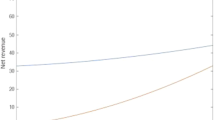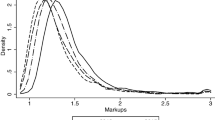Abstract
An increasing concern for climate change puts pressure on industrial firms to achieve carbon emission reductions. These could be realized through cooperation among firms in industrial chains, which leads to industrial symbiosis. By taking a real options approach, we make the timing component of the investment decisions explicit. This is important in assessing the impact of carbon-reducing investment over a specific time-span. We show that a joint venture between a CO2 emitting firm and a firm that can use the CO2 will result in a higher probability that an investment in CO2 capture will take place within a specific time period, which reduces the amount of CO2 emitted substantially. We also show that, in addition to industrial symbiosis, cooperation between firms can benefit from “market symbiosis” as well, in the sense that investments are more likely to take place in markets that are positively correlated. This is an important result, given that the EU has set binding targets to its Member States for reducing their emissions.










Similar content being viewed by others
Notes
Note that continuity of \(V_J\) and \(F_J\) imply that \({{\mathcal {C}}}\) is an open set.
References
Agi MAN, Faramarzi-Oghani S, Öncü Hazır (2020) Game theory-based models in green supply chain management: a review of the literature. Int J Prod Res 59:4736–4755
Albino V, Fraccascia L, Giannoccaro I (2016) Exploring the role of contracts to support the emergence of self-organized industrial symbiosis networks: an agent-based simulation study. J Clean Prod 112:4353–4366
Aliprantis C, Border K (2006) Infinite dimensional analysis, 3rd edn. Springer, Berlin
Banerjee S, Güçbilmez U, Pawlina G (2014) Optimal exercise of jointly held real options: a Nash bargaining approach with value diversion. Eur J Oper Res 239(2):565–578
Bicer I, Hagspiel V (2016) Valuing quantity flexibility under supply chain disintermediation risk. Int J Prod Econ 180:1–15
Boomsma TK, Linnerud K (2015) Market and policy risk under different renewable electricity support schemes. Energy 89:435–448
Bosetti V, Carraro C, Tavoni M (2012) Timing of mitigation and technology availability in achieving a low-carbon world. Environ Resour Econ 51(3):353–369
Chen P (2012) The investment strategies for a dynamic supply chain under stochastic demands. Int J Prod Econ 139(1):80–89
Chertow MR (2000) Industrial symbiosis: literature and taxonomy. Annu Rev Energy Environ 25(1):313–337
Chiou J-R, Hu J-L (2001) Environmental research joint ventures under emission taxes. Environ Resour Econ 20(2):129–146
Compernolle T, Welkenhuysen K, Huisman K, Piessens K, Kort P (2017) Off-shore enhanced oil recovery in the north sea: the impact of price uncertainty on the investment decisions. Energy Policy 101:123–137
Dixit A, Pindyck R (1994) Investment under uncertainty. Princeton University Press, Princeton
European Commission (2014) A policy framework for climate and energy: the period from 2020 to 2030. Communication from the Commission to the European Parliament, the Council, the European Economic and Social Committee and the Committee of the Regions
Fahimnia B, Sarkis J, Davarzani H (2015) Green supply chain management: a review and bibliometric analysis. Int J Prod Econ 162:101–114
Ghiat I, Al-Ansari T (2021) A review of carbon capture and utilisation as a CO2 abatement opportunity within the EWF nexus. J CO2 Util 45:101432
Ghosh D, Shah J (2015) Supply chain analysis under green sensitive consumer demand and cost sharing contract. Int J Prod Econ 164:319–329
Halland E, Pham V, Riis F, Hansen A-H (2018) CO2 for EOR combined with storage in the Norwegian North Sea. In: 14th Greenhouse gas control technologies conference Melbourne 21–26 October 2018 (GHGT-14)
He M, Jin Y, Zeng H, Cao J (2020) Pricing decisions about waste recycling from the perspective of industrial symbiosis in an industrial park: a game model and its application. J Clean Prod 251:119417
International Energy Agency (2020) CCUS in clean energy transitions—IEA, Paris
Kushner H (1997) Numerical methods for stochastic control problems in finance. In: Dempster M, Pliska S (eds) Mathematics of derivative securities. Cambridge University Press, Cambridge
Kushner H, Dupuis P (2001) Numerical methods for stochastic control problems in continuous time, 2nd edn. Springer, Berlin
Lukas E, Welling A (2014) Timing and eco(nomic) efficiency of climate-friendly investments in supply chains. Eur J Oper Res 233(2):448–457
Naims H (2020) Economic aspirations connected to innovations in carbon capture and utilization value chains. J Ind Ecol 24(5):1126–1139
Øksendal B (2000) Stochastic differential equations, 5th edn. Springer, Berlin
Quandl (2021) ECX EUA futures. https://www.quandl.com
Roefs P, Moretti M, Welkenhuysen K, Piessens K, Compernolle T (2019) CO2-enhanced oil recovery and CO2 capture and storage: an environmental economic trade-off analysis. J Environ Manag 239:167–177
US Energy Information Administration (2021) Spot prices for crude oil and petroleum products. https://www.eia.gov/dnav/pet/hist/rbrteW.htm. Accessed 5 July 2021
Wang X, Qie S (2018) When to invest in carbon capture and storage: a perspective of supply chain. Comput Ind Eng 123:26–32
World Bank (2021) State and trends of carbon pricing 2021. World Bank, Washington, DC. https://openknowledge.worldbank.org/handle/10986/35620. License: CC BY 3.0 IGO
Zhang B, Wang Z (2014) Inter-firm collaborations on carbon emission reduction within industrial chains in China: practices, drivers and effects on firms’ performances. Energy Econ 42:115–131
Zhang D, Alhorr Y, Elsarrag E, Marafia AH, Lettieri P, Papageorgiou LG (2017) Fair design of ccs infrastructure for power plants in Qatar under carbon trading scheme. Int J Greenh Gas Control 56:43–54
Author information
Authors and Affiliations
Corresponding author
Additional information
Publisher's Note
Springer Nature remains neutral with regard to jurisdictional claims in published maps and institutional affiliations.
Appendices
Appendix 1: Proof of Proposition 2
To keep notation simple we identify \(X=P_U\) and \(Y=P_D\). We restrict attention to the set E of points in \({\mathbb{R}}^2_+\) where all the first and second-order partial derivatives of \(\varphi \) are well-defined. Note that for every \(t\ge 0\) it holds that \((X_t,Y_t)\in E\), \({\mathbb{P}}\)-a.s.
For any \(\varphi \ge F_J\) that is \(C^2\)-a.e., the HJB equation (13) can be re-written as a pair of variational inequalities on \({\mathbb{R}}^2_+\):
Let
and define the stopping time
Noting that
on \(\{\tau _{{\mathcal {C}}}=\infty \}\), it follows from Dynkin’s formula (see, e.g., Øksendal 2000) and the fact that \(\varphi =F_J\) on \(\partial {{\mathcal {C}}}\) (by a.s.-continuity of sample paths) that
Now consider any other stopping time \(\tau \in {{\mathcal {M}}}\). Then another application of Dynkin’s formula shows that
Therefore, it follows that \(V_J=\varphi \) and that the optimal stopping time in (14) is \(\tau _{{\mathcal {C}}}\), as claimed. \(\square \)
Appendix 2: Numerical Implementation
Our numerical implementation of the optimal stopping problem (12) uses the Markov chain approximation method as described in, e.g., Kushner (1997) and Kushner and Dupuis (2001). Our optimal stopping problem is of the form
where
and \(x\mapsto c(x)\) represents the running costs, which are here given by the costs of CO2 emissions.
For numerical stability is desirable to use the following transformation of variables:
Letting the functions \({\hat{F}}:{\mathbb{R}}_2\rightarrow {\mathbb{R}}\) and \({\hat{c}}:{\mathbb{R}}\rightarrow {\mathbb{R}}\) be such that
we can then rewrite (14) as
where
which has the property that
Note that a straightforward application of Ito’s lemma gives that
The basic idea is to replace the the continuous-time stochastic process (U, V) by a discrete-time Markov chain \((U^h,V^h)\), where \(h>0\) is the step-size on a grid over
for some \({\underline{u}}<{\overline{u}}\) and \({\underline{v}}<{\overline{v}}\) that ensure that G is large enough to produce an accurate approximation to \({\hat{V}}\). In our case we choose
Any point (u,v) on the grid is such that
Introducing, for each \(a\in {\mathbb{R}}\), the notation \(a^+:=\max \{0,a\}\) and \(a^-:=\max \{-a,0\}\), the approximating Markov chain on the grid has the following transition probabilities on \({{\mathcal {N}}}^h_u\times {{\mathcal {N}}}^h_v\):
where
Note that the transition probabilities are non-negative if \(\rho =0\) or if
Given a grid \({{\mathcal {N}}}_u^h\times {{\mathcal {N}}}_v^h\), our time disretization is chosen such that our discrete-time Markov chain approximation of (14) (to be defined below) converges (weakly) to (14). It turns out (see, e.g., Kushner and Dupuis 2001) that a sequence of time points with (potentially state-dependent) time intervals of length
achieves this.
From Proposition 2 we know that the solution to (14) should satisfy the Hamilton–Jacobi–Bellman (HJB) equation
here written as a fixed-point equation, where \({{\mathscr {L}}}\) is the characteristic operator of (U,V), i.e.
Using the transition probabilities of our Markov chain approximation we can discretize the characteristic operator for functions \(\varphi ^h\) defined on the grid \({{\mathcal {N}}}_u^h\times {{\mathcal {N}}}_v^h\):
We now replace the HJB equation (15) by the discrete-time approximation
where the operator T is given by
Using Blackwell’s theorem (Aliprantis and Border 2006, Theorem 3.53), it is fairly easy to show that the operator T is a contraction mapping. From the Banach fixed point theorem (Aliprantis and Border 2006, Theorem 3.48) it follows that the fixed-point problem (16) has a unique fixed point. In addition, repeated application of T leads to convergence to the fixed point \(W^h\), which then acts as our approximation to the value function V.
To summarize, we start with an initial guess \(W^h_0\) on the grid \({{\mathcal {N}}}^h_u\times {{\mathcal {N}}}^h_v\). From this initial guess we extract an initial guess of the continuation region, \(G_0\), by extracting all points \((u,v)\in {{\mathcal {N}}}^h_u\times {{\mathcal {N}}}^h_v\) for which \(W_0^h(u,v)>{\hat{F}}(u,v)\). We then compute a new iteration, \(W_1^h\) by applying the operator T, i.e.
This procedure is repeated until the change between \(W^h_n\) and \(W^h_{n-1}\) (in the sup norm) falls below 1. That is, our final approximation is to the nearest $1,000.
Rights and permissions
About this article
Cite this article
Compernolle, T., Thijssen, J.J.J. The Role of Industrial and Market Symbiosis in Stimulating CO2 Emission Reductions. Environ Resource Econ 83, 171–197 (2022). https://doi.org/10.1007/s10640-021-00616-3
Accepted:
Published:
Issue Date:
DOI: https://doi.org/10.1007/s10640-021-00616-3




